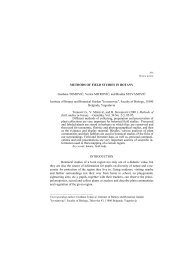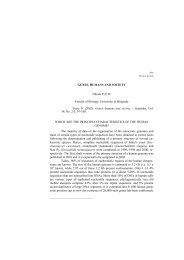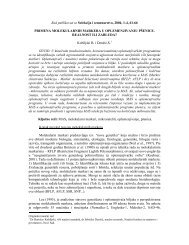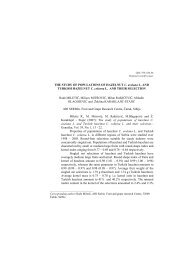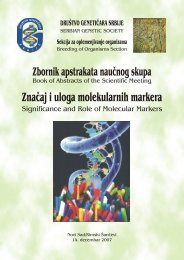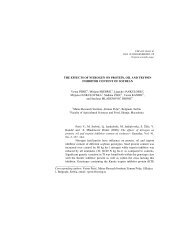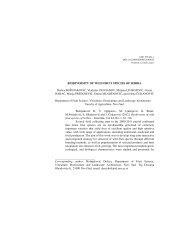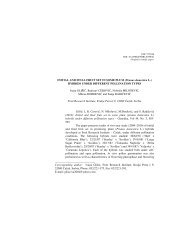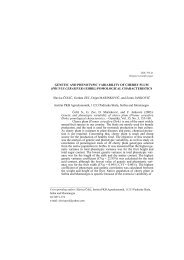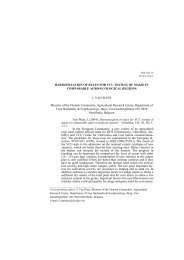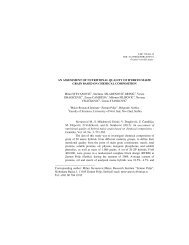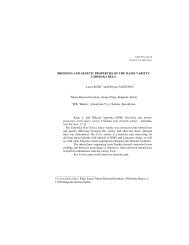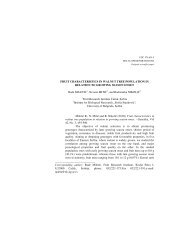Zbornik - Društvo genetičara Srbije
Zbornik - Društvo genetičara Srbije
Zbornik - Društvo genetičara Srbije
You also want an ePaper? Increase the reach of your titles
YUMPU automatically turns print PDFs into web optimized ePapers that Google loves.
IV-Usm-6 ZBORNIK ABSTRAKATA III KONGRESA GENETIÈARA SRBIJE 95<br />
Subotica, 30. novembar - 4. decembar 2004.<br />
OPLEMENJIVANJE PŠENICE NA OTPORNOST PREMA<br />
NISKIM TEMPERATURAMA<br />
N. Hristov i N. Mladenov<br />
Nauèni institut za ratarstvo i povrtarstvo, Novi Sad<br />
Otpornost prema niskim temperaturama od velikog je znaèaja u proizvodnji pšenice. To<br />
se posebno istièe u godinama kao što je bila 2002/03, kada su znaèajne površine pod<br />
itaricama izmrzle. Spuštanjem temperature ispod –10°C bez snega, javlja se opasnost od<br />
ošteæenja lisne mase. Ukoliko golomrazica traje due od 48 èasova, a temperatura se<br />
spusti ispod –15°C, moe doæi i do izmrzavanja èvora bokorenja, èak i kod tolerantnih<br />
genotipova. Imajuæi u vidu stalni napredak u oplemenjivanju biljaka, u ovom radu je<br />
analizirano 23 sorte pšenice iz razlièitih etapa oplemenjivanja. Testiranje je izvršeno u<br />
hladnim komorama na temperaturi –15°C u trajanju od 24, 36, 48 i 60 èasova. Sve sorte<br />
su podeljene u tri grupe u zavisnosti od godine priznavanja. U prvoj grupi, u kojoj se<br />
uglavnom nalaze introdukovane sorte, procenat preivelih biljaka na svim tretmanima<br />
iznosio je u proseku 91%. Utvrðeno je da se u okviru ove grupe, sorte meðusobno<br />
razlikuju po otpornosti na niske temperature u zavisnosti od porekla. U drugoj grupi, koju<br />
èine domaæe sorte koje su gajene na velikim površinama 70-ih godina, procenat<br />
preivelih biljaka iznosio je 90,8%. Ovaj podatak ukazuje da je i kod domaæih sorti<br />
postignut izuzetan napredak u pogledu ovog svojstva. Treæu grupu èine sorte novijeg<br />
datuma, koje ujedno predstavljaju i aktuelni sortiment novosadskih sorti pšenice. Kod<br />
ovih sorti, otpornost prema niskim temperaturama se nalazi na nivou prethodne grupe,<br />
pri èemu je procenat preivelih biljaka iznosio 89,2%. U procesu oplemenjivanja vano<br />
je zadrati odreðena svojstva na zadovoljavajuæem nivou, a pri tome unaprediti pre svega<br />
ekonomski vana svojstva, kao što su prinos i kvalitet, što je upravo i ostvareno kod sorti<br />
koje se trenutno nalaze u proizvodnji.<br />
WHEAT BREEDING FOR RESISTANCE TO LOW TEMPERATURE<br />
Resistance to low temperature is important in wheat production, especially in years such<br />
as 2002/03, when winterkill occurred at a large acreage. When temperature drops below<br />
–10°C and there is no snow blanket, leaf mass becomes prone to damage. If such conditions<br />
persist longer than 48 hours and the temperature drops below –15°C, tillering nodes<br />
may freeze even in the case of tolerant genotypes. Twenty-three wheat cultivars from different<br />
breeding cycles have been tested for reaction to exposure to the temperature of<br />
–15°C for 24, 36, 48 and 60 hours. The cultivars were divided in three groups, in dependence<br />
of year of registration. In the first group, consisting mostly of introduced cultivars,<br />
the average percentage of survival in all treatments was 91%. The cultivars in this group<br />
were found to differ in resistance to low temperature in dependence of origin. In the second<br />
group, consisting of the domestic cultivars commercially grown in the 1970’s, the<br />
percentage of survival was 90.8%. This was an indication that the domestic breeding program<br />
had been quite successful with regard to this trait. The third group comprises new<br />
cultivars, those which are currently in the domestic commercial production. Their resistance<br />
to low temperature was 89.2%, at the level of the second group. In breeding process<br />
it is important to maintain certain traits, such as yield and quality, at an appointed level.<br />
This has been fully achieved with the cultivars from the third group.



